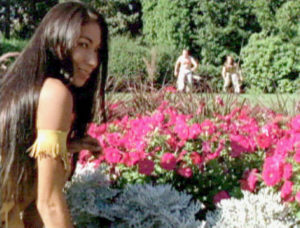Troubling Nostalgia
Online Screening curated by Noor Bhangu

Zwei Indianer Aus Winnipeg by Darryl Nepinak
2008 | 2:40
Two ersatz “Indian warriors” chase a beautiful Indian maiden through the streets of Winnipeg. But she loves Chief Big Bear. Who is the hunter, and who the hunted in this tableau? Based on the 1964 German song, “Zwei Indianer Aus Winnipeg,” our heroes are in for a surprise when they reach the Ancient Lake of Schweinsteiger. The film was commissioned by the imagineNATIVE festival for their Culture Shock program.
Missed the online screening? Watch Zwei Indianer Aus Winnipeg on VUCAVU.com now!

The Indian Miracle by Divya Mehra
2004 | 2:33
A rickshaw driver and passenger chat about selfishness and trees without water.
Missed the online screening? Watch The Indian Miracle on VUCAVU.com now!

Documentary of My Father by Garland Lam Turner
2004 | 2:00
This documentary of the artist’s father is in Cantonese with English subtitles. The visual image is expressed by a technique called stop-motion painting where each stroke is recorded for 2 to 3 seconds. The footage is sped up to create a fluid painting motion. Documentary of My Father is about Lam’s father before she knew him personally, before she was born.
Missed the online screening? Watch Documentary of My Father in VUCAVU.com now!
Troubling Nostalgia curator’s essay:
“Within modernity nostalgia is marginalized. It is treated as a failure to adapt… Nostalgia disturbs modern life.”
-Alastair Bonnett [Left in the Past: Radicalism and the Politics of Nostalgia, p.10]
In recent anti-colonial discourse, nostalgia has been employed as a strategy to revisit and revive pre-contact past on one’s own terms for one’s own. Because of its “failure to adapt” to the structures of modern life, nostalgia is evoked as a radical tool that can trouble the colonial. Through these films, I explore the ways in which nostalgia can also spill into and trouble the lives of those already marked by colonialism. In brushing up against colonial, pre-colonial, and personal sets of nostalgia Darryl Nepinak, Divya Mehra, and Garland Lam Turner deliberate on the persistence of memory in the present. Finally, in being troubled by and, in turn, troubling nostalgia, the artists demonstrate nostalgia’s incompatibility with radical modern life.
Darryl Nepinak’s Zwei Indianer Aus Winnipeg follows the adventures of two white men – costumed as Plains Indians – chasing a young Indigenous woman around the city of Winnipeg. Setting the tone for the drama is a 1964 German song whose chirpy notes facilitate a return to the not-so-distant romantic past when Indigenous bodies and lands were up for grabs. Running after the energetic, albeit bored, woman the hungry men are tricked into Lake of Schwinestieger, which activates their full transformation into indigeneity. Yet even after the emergence of Indigenous life from the fictional lake there linger notes from the German soundtrack – pointing us to consider how colonial nostalgia continues to haunt the contemporary landscape.
Divya Mehra’s The Indian Miracle articulates nostalgia of another variety, one that is produced through anti-colonial means. The film starts with the artist getting inside a motor-rickshaw, asking the driver if he knows the way to Vikram Hotel. After getting in the rickshaw, questions about directions are replaced by a dialogue on Deepak Chopra and ways to find inner peace. Deepak Chopra, like other self-help gurus, represents a peculiar kind of nostalgia that is rooted in the desire to return to pre-colonial India: a time when Hindus, Buddhists, Jains etc. are imagined to have existed in a peaceful whirlpool before the arrival of the Persian and then British colonizers. Mehra asks, “Do we have to ignore the poor to achieve inner peace?” Yes, because the future-oriented nostalgia of Chopra has no space for the troubled conditions of the present.
Sitting close to Nepinak and Mehra is the artist, Garland Lam Turner, whose work, Documentary of My Father, presents on the inheritance of familial history and the inheritor’s place within it. Produced through the technique of stop-motion painting, the film recounts the life of the artist’s father – his birth in Hong Kong, life under the Japanese invasion, education, work, marriage, and his eventual move to Canada. Lam’s film gives in completely to the unraveling of her father’s life and his portrait until the final moment, when the artist steps inside the frame to distinguish her place within her father’s narrative. Listening to one’s parents and their immigration histories is an ethical action but it is also true that listening can easily dissolve into a secondhand nostalgia, which can then encroach upon and diminish the agency of the listener.
About the curator:
Harnoor Bhangu holds a BA in History of Art from the University of Winnipeg, where she is currently working on her MA in Cultural Studies: Curatorial Practices. She focuses primarily on South Asian, Central Asian and Middle-Eastern artists who interrogate gender, religion and diaspora in their work. In her recent work, she has begun to look critically at the ways in which marginalized bodies take up or contest spaces online.
